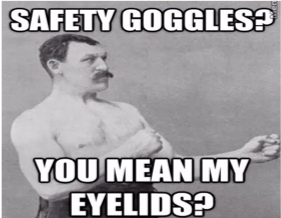Are you in danger of becoming a statistic?
Protecting your eyes and face is important in the workplace and outside of work. Thousands of people are blinded each year from work related eye injuries that could have been prevented with proper eye and face protection.
The Occupational Safety and Health Association (OSHA) requires employers to ensure the safety of all employees in the work environment however, eye injuries in the workplace are very common. According to the National Institute for Occupational Safety and Health, every day 2,000 U.S. workers experience job related eye injuries that require medical treatment. In addition, the American Optometric Association warns healthcare workers, laboratory, and janitorial staff may be at risk of acquiring infectious diseases from eye exposure. This can occur through direct exposure to blood splashes, respiratory droplets generated during coughing, or from touching the eyes with contaminated fingers or objects.

- Know what Personal Protective Equipment (PPE) is required.
- Review the Personal Protective Equipment Assessment Form (for Research Laboratories) found in your lab’s EHSO Lab Safety Binder.
- Review the Personal Protective Equipment Assessment Form (for Research Laboratories) found in your lab’s EHSO Lab Safety Binder.
- Know the lab’s standard operating procedures.
- Know where the eyewash stations are in your lab area.
- Flush the eyewash stations monthly.
- Always wear safety goggles and a full-face shield when transferring liquid nitrogen.
- Wear ANSI approved glasses for the appropriate wave length when working with lasers.
- Eye and face protection should be worn to prevent exposure of blood or infectious materials in the eyes or face.
- This route of exposure is one of five predominant routes of laboratory acquired infections.
- This route of exposure is one of five predominant routes of laboratory acquired infections.
- Eye and face protection also help prevent accidental contact from contaminated gloved hands to the eyes, nose, or mouth.
- Wear eye and mucosal protection when there is risk for splash, for example, when transferring buffers from a cylinder to beaker.

What to do in case of an exposure:
- Flush the contaminated area for 15 minutes.
- Seek medical attention.
- Notify your supervisor and Occupational Injury Management at 404-686-5500.
- Report the incident through PeopleSoft.

When not in the Lab:
- Do you wear safety glasses when cutting your lawn?
- Do you wear eye protection when working on the house or weekend projects?
- Do you receive annual eye exams?
- Do you wear sunglasses to protect from UV light when outside?
- Do you use goggles or a mask when playing sports such as racquetball or lacrosse?
OSHA provides detailed information on recognizing eye and face hazards as well as possible solutions for these hazards. See: https://www.osha.gov/SLTC/eyefaceprotection/hazards.html.
Contact your EHSO Research Safety building liaison for any additional help in evaluating PPE.
Image credits:
Leave a Reply